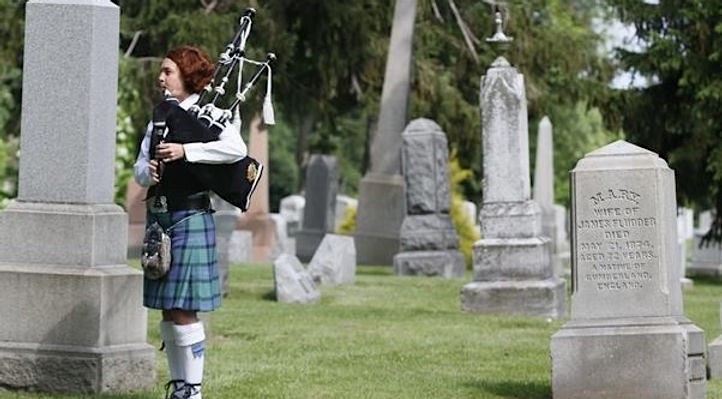Dressed in her tartan kilt and white shirt and carrying her 7-pound instrument, the 5-foot-5 redheaded bagpiper can strike quite a pose. As she presses the bag and blows, a lugubrious vibrato gradually builds into a haunting skirl. Within minutes, the majestic sounds of the Great Highland pipes dominate the air.
“When I was young, I was extremely shy and wouldn’t say a peep,” Marley Becker explains. She describes how her face turned beet red whenever she was called on in class. “Not until college, really, did I come out of my shell.” It was a passion for woodwinds that liberated her spirit.
Proficient in both the flute and the bassoon, the self-described band nerd joined campus music groups and connected with peers through a shared love of music. In the fall of 2005, three years after graduating from college, she yearned to be part of a group again. She was also eager to tackle a new instrument. Over the years, she had become fascinated with bagpipes. How hard would it be to learn the instrument? How difficult would it be to find a band? She did some research and made a few calls. The pipe band major from the Celtic Spirit Pipe Band invited her to a rehearsal. “He said he would teach me how to play for free, as long as I joined the band.”
For the next several months, Becker learned to play on a practice chanter, a double-reeded woodwind instrument that resembles a recorder. Then on March 17, 2006 — St. Patrick’s Day, fittingly — she picked up her own set of bagpipes from The British Shop on Englewood in Kenmore. Although many varieties of bagpipes can be found throughout Europe and in parts of Asia, in the Celtic world the two main types are Irish (Uilleann) and Scottish. Becker’s Great Highland bagpipes, native to Scotland and arguably the most famous of the Celtic pipes, have four main parts: a blowpipe with a mouthpiece, a bag that fits under the arm, a bass drone and two tenor drones that lean against the shoulder, and a chanter (a melody stick).
When Becker first tried out her new instrument, the best she could manage was a few pitiful sounds from the drones. “This was going to be a lot more difficult than I thought it would be.” It took her a few months to produce some respectable notes, and six more months before she was playing songs. She remembers practicing one afternoon, only to have a neighbor stop by and inquire what the awful noise was. “You know when someone is just starting the violin? The bagpipes are even worse!” she laughs. The key, she was quickly learning, was to balance the sounds from the different pipes.
Fifteen years later, the bagpipes are a natural extension of the musician’s soulful personality. She is drawn to the beauty of the plaintive sounds of an instrument that some historians trace back to ancient Egypt. “Ioften get lost in the music, and during practice, I may even miss my cue to come in.” Becker explains that traditional bagpipe music is highly regimented and played a certain way. Her group puts their own twist on Celtic music, through modern arrangements that combine several other instruments with bagpipes. “We play with our hearts.” The band has performed at numerous festivals and parades, and in 2008, the musicians had the pleasure of leading the Buffalo Sabres National Hockey League team out onto the ice for the Ice Bowl.
Of Becker’s many solo gigs, the most meaningful have often been the memorial services. She played at the funeral of the first female musician of the Buffalo Philharmonic Orchestra, an upright bass player who had requested a female bagpiper for her service. This past summer Becker was honored to play at the funeral service for a 95-year-old United States Marine veteran who had fought in World War Two. Other, far less somber solo engagements include a lavish dinner party at a mansion once owned by the Catholic Diocese of Buffalo. And in contrast to the neighbor who complained 15 years ago, back when Becker was first learning the bagpipes, a different neighbor recently left a note at the musician’s door. She wanted to know if Becker could stand in the back yard and play “Happy Birthday” for her husband’s 50th birthday.
The piper smiles broadly when recalling her childhood reticence. “It’s interesting that I picked out the loudest instrument. Was it me finally coming out of my shell and being bold?”
To learn more about Marley Becker and her music, check out her website.

